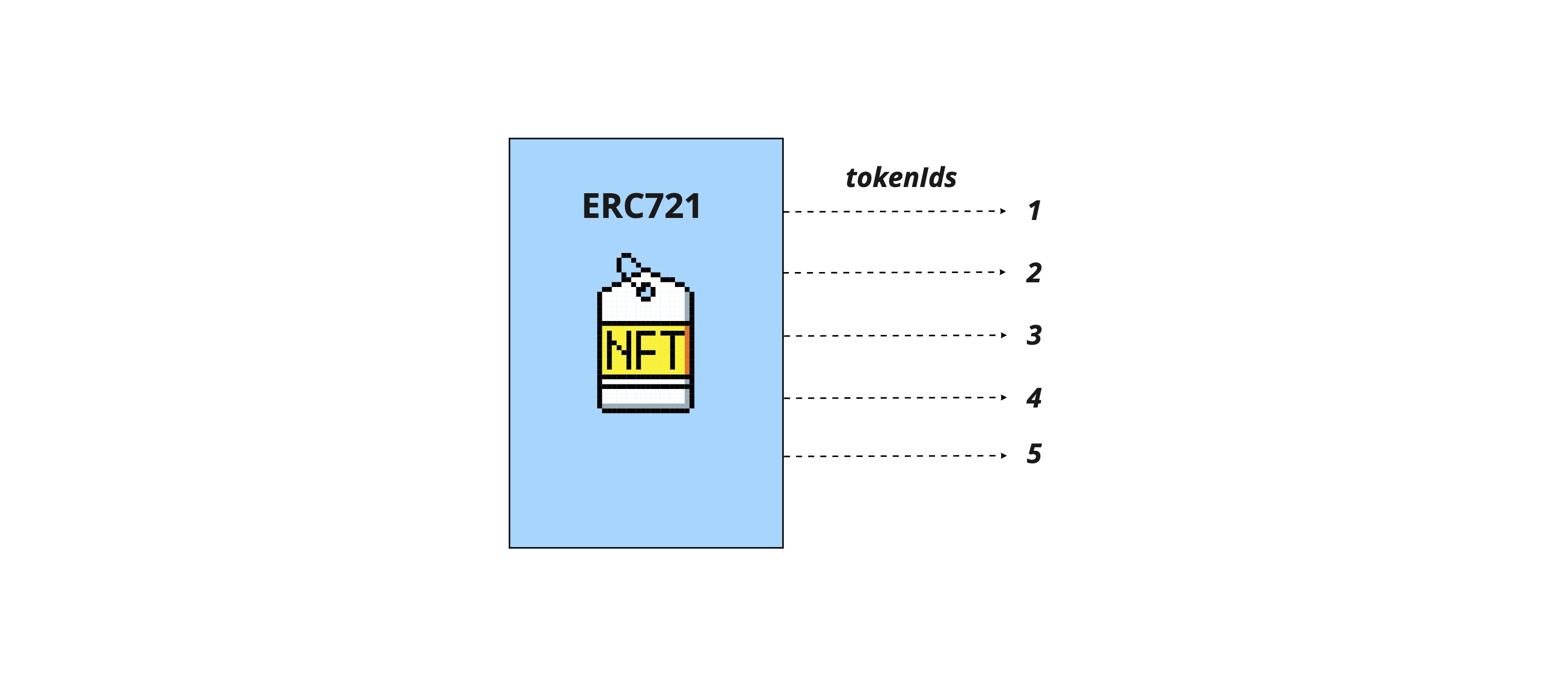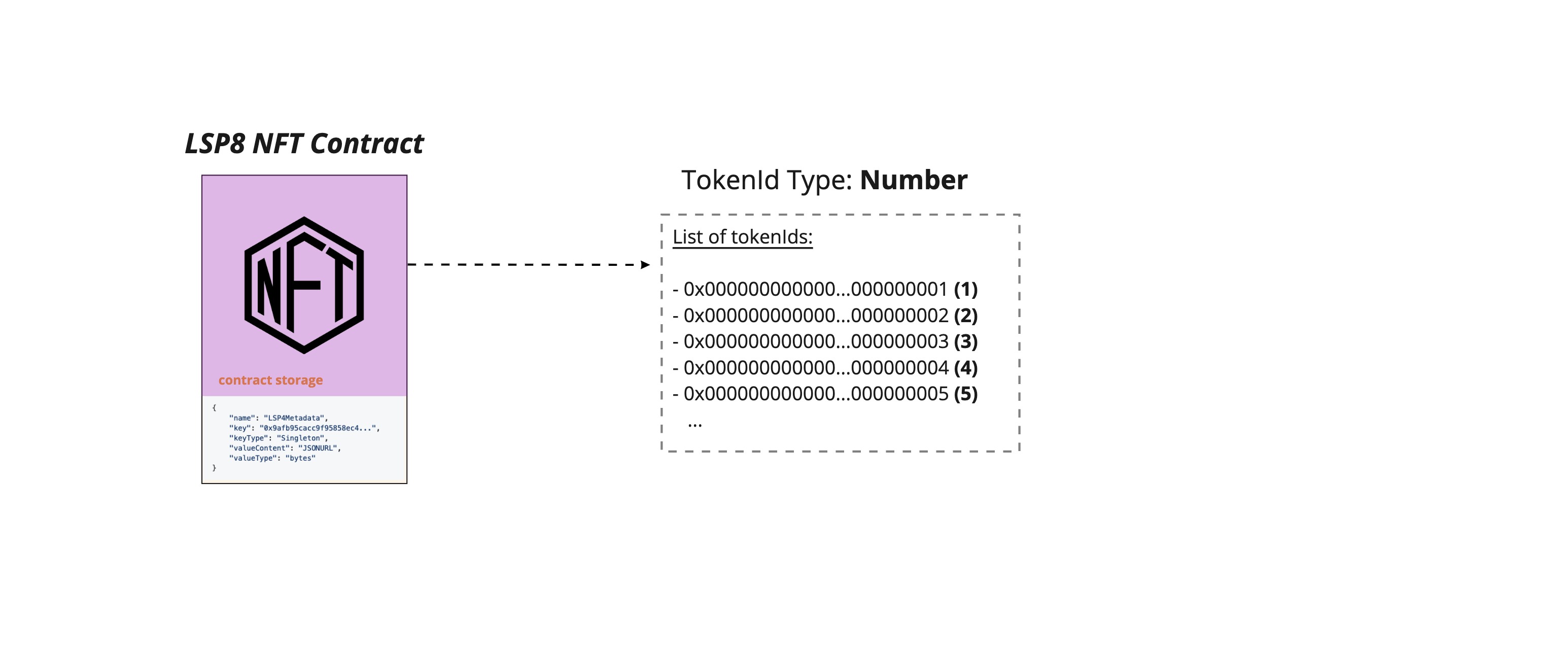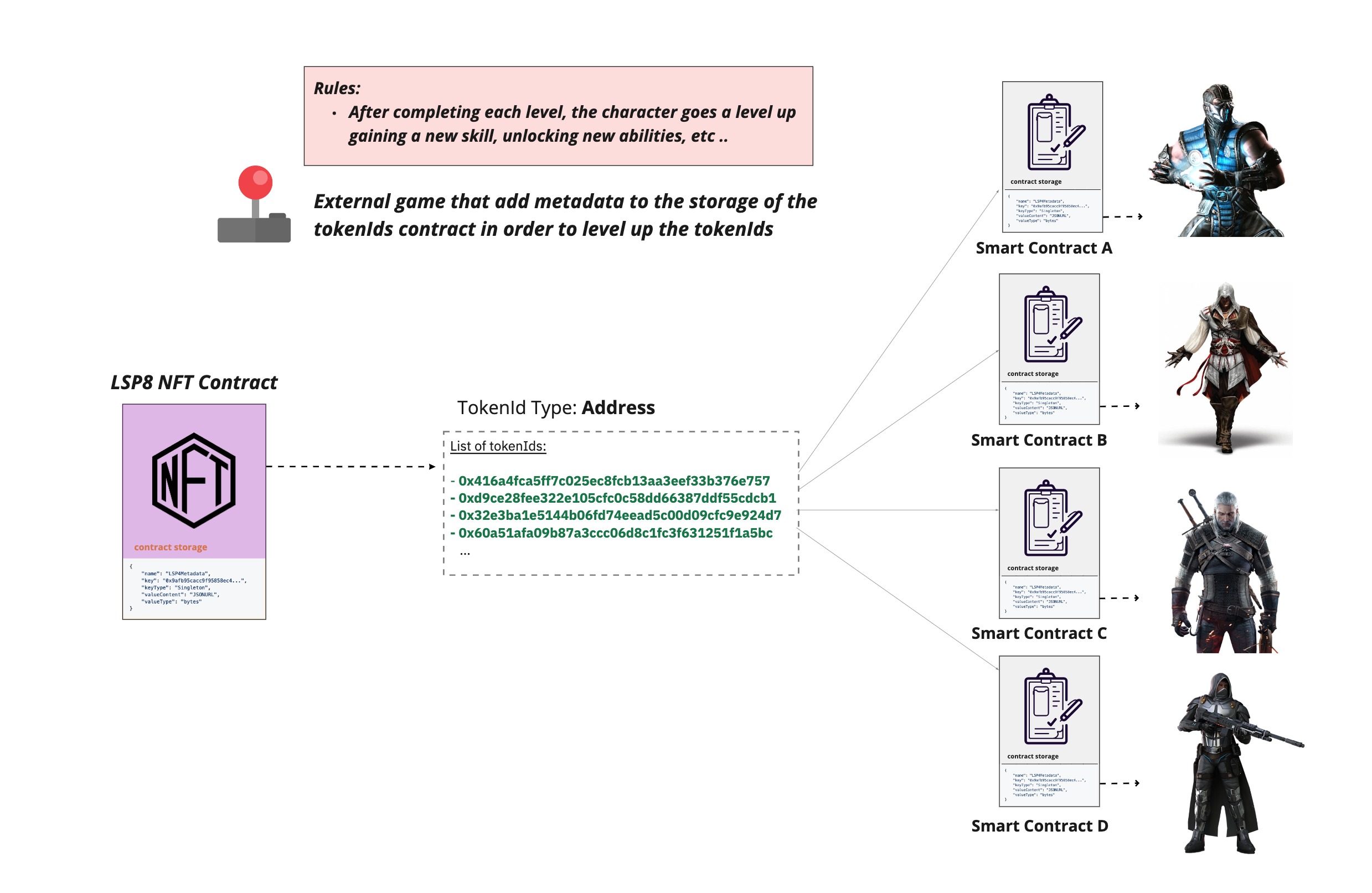LSP8 - Identifiable Digital Asset
Introduction
Non-Fungible assets such as ERC721 and ERC1155 tokens have a lot of limitations in terms of metadata, secure transfers, asset representation, and asset interaction. This causes problems for users seeking, full control over which assets they accept or not, more complex NFT functionality, and a simple user experience while creating, buying, and exchanging assets.
LSP8-IdentifiableDigitalAsset is the standard that aims to solve all problems mentioned above by:
- Allowing more secure transfers via force boolean parameter.
- More asset metadata via LSP4-DigitalAssetMetadata.
- More asset representation via bytes32 tokenIds.
- More interaction between the asset contract and the asset sender/recipient via token hooks.

Specification
LSP8-IdentifiableDigitalAsset is a standard that aims to describe non-fungible assets. The term Non-fungible means that each asset is unique and different. They are distinguishable from each other and therefore not interchangeable.
This standard was based on ERC721 and ERC1155 with additional features mentioned below:
Format of TokenIds
The current NFT standards such as ERC721 and ERC1155 lack asset representation as they define the tokenIds as Numbers (uint256). Each token from the NFT collection will be defined and queried based on this tokenId, which is normally incremental.

LSP8-IdentifiableDigitalAsset defines the tokenIds as bytes32 to allow a wide variety of representation, including numbers, string names, smart contract addresses, byte identifiers for serial numbers, or even hashed values.
Finally a LSP8 Collection contract can also contains NFTs of different formats, illustrated under the Mixed Formats tab below. For instance all the NFTs by default are of the number format, but certain NFTs in the collection could be more complex and represented as their own smart contract. In this example use case, the tokenId format will be Mixed with default as address (Value 102).
- One Single TokenId Format
- Mixed TokenIds Formats
| Value | Format | Representation | Description |
|---|---|---|---|
0 | uint256 | Number | each NFT is parsed as a unique number. |
1 | string | String | each NFT is parsed as a unique name (as a short utf8 encoded string, no more than 32 characters long) |
2 | address | Smart Contract | each NFT is parsed as its own smart contract that can hold its own logic and metadata (e.g [ERC725Y] compatible). |
3 | bytes32 | Unique Bytes | each NFT is parsed as a 32 bytes long unique identifier. |
4 | bytes32 | Hash Digest | each NFT is parsed as a 32 bytes hash digest. This can be used as the hash of a very long string representing the tokenId. |
| Value | Format | Description |
|---|---|---|
100 | Mixed with default as uint256 | Default NFT is parsed as a unique number with querying the LSP8TokenIdFormat for each tokenId. |
101 | Mixed with default as string | Default NFT is parsed as a unique name (as a short utf8 encoded string, no more than 32 characters long) with querying the LSP8TokenIdFormat for each tokenId. |
102 | Mixed with default as address | Default NFT is parsed as its own smart contract that can hold its own logic and metadata (e.g [ERC725Y] compatible) with querying the LSP8TokenIdFormat for each tokenId. . |
103 | Mixed with default as bytes32 unique bytes | Default NFT is parsed as a 32 bytes long unique identifier with querying the LSP8TokenIdFormat for each tokenId. |
104 | Mixed with default as bytes32 hash digest | Default NFT is parsed as a 32 bytes hash digestwith querying the LSP8TokenIdFormat for each tokenId. |
The bytes32 tokenId can be interpreted as a:
- Number:

- Hashed Value:

- Contract Address:

TokenIds represented as smart contract address allow the creation of more complex NFTs. When each tokenId is a contract that have its own ERC725Y storage. For instance in a video game, by changing the features and metadata of the tokenId based on the game rules.

Unlimited Metadata
To mark the asset authenticity, it's advised to use a combination between LSP4-DigitalAssetMetadata and LSP12-IssuedAssets.
The current token standards don't enable attaching metadata to the contract in a generic and flexible way, they set the name, symbol, and tokenURI. This is limiting for a digital asset that may want to list the creators, the community behind it, and to have the ability to update the metadata of the token and the tokenIds over time depending on a certain logic (Evolving tokens).
To ensure a flexible and generic asset representation, the token contract should use the LSP4-DigitalAsset-Metadata. In this way, any information could be attached to the token contract.
The Metadata defined by the ERC725Y Data Keys can be set for each tokenId, not just for the whole NFT collection. Check LSP8 ERC725Y Data Keys in the LSP8 Standard Document.
LSP1 Token Hooks
When LSP8 assets are transferred, the LSP8 contract will notify the token sender and recipient using _notifyTokenSender(...) and _notifyTokenReceiver(...).
These methods will make external calls to the universalReceiver(...) functions of both the sender and recipient.
This function could perform more complex logic, like delegating the call to the LSP1UniversalReceiverDelegate contract. This contract can contain custom logic for each user. For instance, a user could decide to re-transfer the tokens to another address once they are transferred to his UP.
The current NFTs standards act as registry contracts that keep track of the ownership of each tokenId. They do not implement functionalities to notify the recipient that it has received some tokens or to notify the sender that it has sent some tokens.
During an ERC721 token transfer, the ownership of the tokenId is changed from the sender address to the recipient address without further interaction.

During an LSP8 token transfer, as well as updating the tokenId ownership, both the sender and recipient are informed of the transfer by calling the universalReceiever(...) function on their profiles.

In this way, users are informed about the NFT transfer and can decide how to react on the transfer, either by accepting or rejecting the NFT, or implementing a custom logic to run on each transfer with the help of LSP1-UniversalReceiverDelegate.
If the sender and recipient are smart contracts that implement the LSP1 standard, the LSP8 token contract will notify them using the following bytes32 typeIds when calling their universalReceiver(...) function.
| address notified | bytes32 typeId used | description |
|---|---|---|
Token sender (from) | 0xb23eae7e6d1564b295b4c3e3be402d9a2f0776c57bdf365903496f6fa481ab00 | keccak256('LSP8Tokens_SenderNotification') |
Token recipient (to) | 0x0b084a55ebf70fd3c06fd755269dac2212c4d3f0f4d09079780bfa50c1b2984d | keccak256('LSP8Tokens_RecipientNotification') |
Token Operator (operator) | 0x468cd1581d7bc001c3b685513d2b929b55437be34700410383d58f3aa1ea0abc | keccak256('LSP8Tokens_OperatorNotification') |
force mint and transfer
When transferring or minting tokens, it is advised to set the force boolean to false by default to ensure tokens won't be lost if sent accidentally to the wrong EOA or contract address. For instance, if the wrong address was pasted by mistake by the user in the input field of a dApp.
It is expected in the LUKSO's ecosystem to use smart contract based accounts to interact on the blockchain. This includes sending and receiving tokens. EOAs can receive tokens, but should be used mainly to control these accounts, not to interact on the network or hold tokens.
To ensure a safe asset transfer, an additional boolean parameter was added to the transfer(...) and _mint(...) functions:
- If set to
false, the transfer will only pass if the recipient is a smart contract that implements the LSP1-UniversalReceiver standard.

- If set to
true, the transfer will not be dependent on the recipient, meaning smart contracts not implementing the LSP1-UniversalReceiver standard and EOAs will be able to receive the tokens.

Implementing the LSP1-UniversalReceiver standard will give a sign that the contract knows how to handle the tokens received.
LSP8 Collection vs TokenId Metadata
The LSP8 standard offers ways to set metadata for the whole LSP8 collection as well as metadata per specific token Id. This is done using the same LSP4Metadata data key, but different functions.
-
The generic metadata and information related to the whole LSP8 collection can be updated using
setData(bytes32,bytes)orsetDataBatch(bytes[],bytes[]), passing thebytes32data key ofLSP4Metadataas the first argument. -
Alternatively, the generic information and metadata specific to a
tokenIdcan be set using thesetDataForTokenIdorsetDataBatchForTokenIds(bytes32[],bytes32[],bytes[])functions.